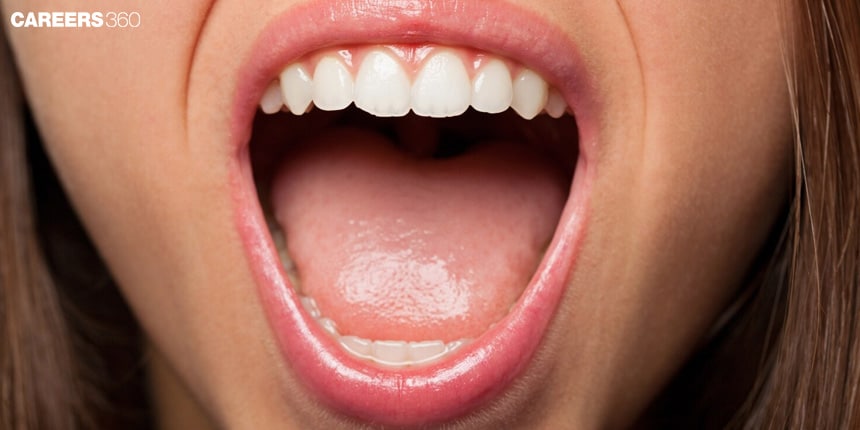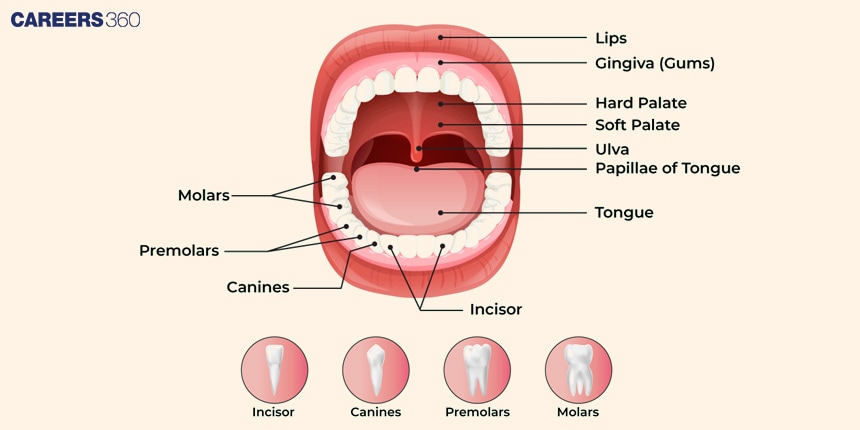The Mouth and Buccal Cavity: Definition, Anatomy, Function, Parts, Process
Overview Of The Mouth And Buccal Cavity
The mouth, or oral cavity, is the beginning, or entrance, of chewed food and liquid material into the digestive tract. Even more specifically, the oral cavity space is referred to as the buccal cavity.
Overall, the mouth and buccal cavity give way to the early stages of the digestive process—both mechanical and chemical. The integrity of the mouth and buccal cavity is very important for maintaining general health because it is implicated in nutrition, phonation, and even social relations.
Anatomy Of The Mouth And Buccal Cavity
- External and Internal Structures: The lips, cheeks, teeth, tongue, and palate.
The buccal cavity contains the space between the lips and cheeks and the teeth and gums.
NEET 2025: Mock Test Series | Syllabus | High Scoring Topics | PYQs
NEET Important PYQ's Subject wise: Physics | Chemistry | Biology
New: Meet Careers360 B.Tech/NEET Experts in your City | Book your Seat now
- Overview Of The Mouth And Buccal Cavity
- Anatomy Of The Mouth And Buccal Cavity
- Functions of Mouth and Buccal Cavity
- Parts Of The Mouth And Buccal Cavity
- Common Disorders Of The Mouth And Buccal Cavity
- The Video Recommended On Mouth And Buccal Cavity:

Functions of Mouth and Buccal Cavity
The mouth and buccal cavity play important roles in various processes:
Mechanical Digestion
The teeth chew the food and the tongue mixes the with saliva.
There are different types of teeth which have different specialisations of function such as the incisors, canines, premolars and the molars.
Chemical Digestion
Saliva moistens food for easier swallowing and breaks down starches.
Amylase is the catalytic enzyme present in the saliva, which starts the digestion of carbohydrates.
Diagram: Mouth And Buccal Cavity
The diagram given below shows the structure and different parts of the buccal cavity.

Speech and Communication
The mouth and tongue are very important organs in articulation in the formation of speech and sounds.
Sensory Functions
Taste papillae on the tongue, and olfactory receptors in the nose
Parts Of The Mouth And Buccal Cavity
The parts of the mouth and buccal cavity include:
Teeth
Incisors, canines, premolars, and molars.
The human dental formula and the general arrangement in the mouth.
Tongue
The muscular organ, the tongue, has different parts that have specialised areas for different functions.
It helps in taste, articulation, and food movement during chewing.
Salivary Glands
The parotid, submandibular, and sublingual are the three types.
The gland largely secretes saliva that does much for digestion and lubricating the space in the mouth. This may also go a long way to keeping the mouth moist..
Lips and Cheeks
Lips and cheeks retain food as well as for speech.
Common Disorders Of The Mouth And Buccal Cavity
Some of the common disorders of the mouth and buccal cavity are:
Dental Caries and Cavities
Causes: Bacterial plaque, sugary diet, and poor oral hygiene.
Symptoms: Toothache, visible pits or holes in teeth, sensitivity.
Prevention: Regular brushing and flossing, reducing sugary foods, routine dental check-ups.
Periodontal Disease
Causes: Plaque buildup, poor oral hygiene, smoking.
Symptoms: Swollen gums, bleeding gums, loose teeth.
Course of Treatment: Professional cleaning and impeccable oral hygiene usually helps, but surgery may sometimes be required.
Oral Thrush
Cause: Infection of fungus, weak immune, antibiotics.
Symptoms: White sores inside mouth, sore, difficulty swallowing.
Treatment: Antifungal medication, good oral hygiene.
Dry Mouth (Xerostomia)
Cause: Medication, dehydration from the body, some diseases.
Symptoms: Dryness.
The mouth and buccal cavity are related to digestion, speech, and sensation. Perhaps it could be said that questions of proper oral health lead right to general health, nutrition, and communication. It is, therefore, that common disorders be prevented and a healthy mouth maintained with necessary regular oral prophylaxis and dental checkups.
The Video Recommended On Mouth And Buccal Cavity:
Frequently Asked Questions (FAQs)
The mouth and buccal cavity have roles to play in mastication, chemical digestion through the production of saliva, speech and some sensory roles such as taste.
There exist four different types of teeth in humans; incisors, canines, premolars and molars, that cut tear crush and grind, respectively.
The cells of the salivary glands produce saliva. This contains the enzymes to start breaking down carbohydrates and lubricate food to make it easier to swallow down the throat.
Dental caries or cavities, periodontal disease, oral thrush, and xerostomia or dry mouth.
Good oral health extends with the gains of brushing and flossing teeth, good eating, and avoiding habits that may cause injuries and harm, such as smoking.
Also Read
30 Nov'24 03:25 PM
26 Nov'24 05:38 PM
25 Nov'24 06:43 PM
25 Nov'24 05:45 PM
25 Nov'24 04:48 PM
25 Nov'24 03:52 PM
23 Nov'24 04:30 PM
23 Nov'24 10:03 AM

